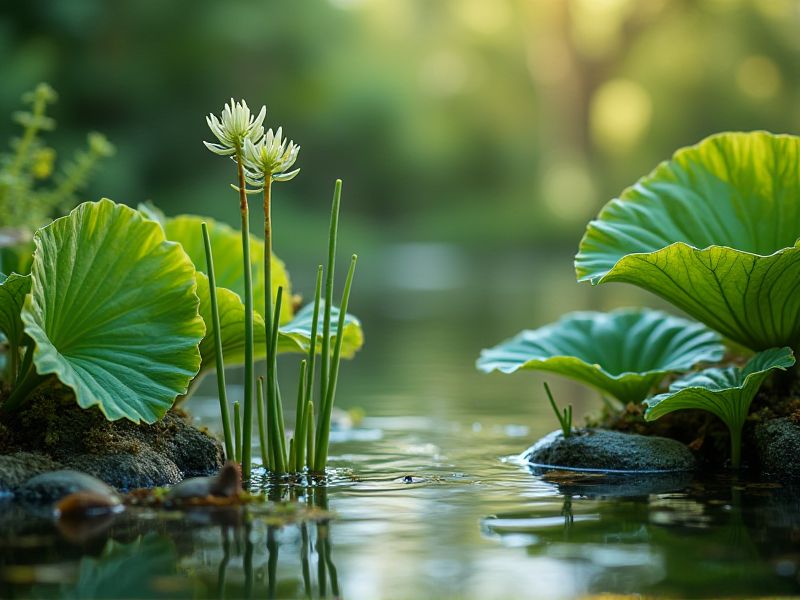
Aquatic plants, such as Water Hyacinth and Duckweed, play a vital role in water purification by absorbing excess nutrients like nitrogen and phosphorus. These plants not only filter pollutants but also provide habitat for aquatic life, enhancing biodiversity in freshwater ecosystems. The presence of submerged plants like Elodea promotes oxygenation, benefiting fish and other aquatic organisms. Your local pond or lake can greatly benefit from the introduction of these natural water cleaners, improving overall water quality and clarity. Implementing these plants in wetland restoration projects can significantly mitigate pollution and create healthier aquatic environments.
List of some Aquatic plants that clean water
- Water Hyacinth (Eichhornia crassipes)
- Duckweed (Lemna minor)
- Water Lettuce (Pistia stratiotes)
- Coontail (Ceratophyllum demersum)
- Hornwort (Ceratophyllum submersum)
- Pickerelweed (Pontederia cordata)
- Azolla (Azolla filiculoides)
- Soft Rush (Juncus effusus)
- Floating Heart (Nymphoides peltata)
- Water Primrose (Ludwigia peploides)
Important things about Aquatic plants that clean water
Nutrient Absorption
Aquatic plants like water lilies, duckweed, and submerged grasses play a crucial role in nutrient absorption, effectively filtering pollutants from water bodies. These plants uptake excess nutrients, such as nitrogen and phosphorus, preventing problems like algal blooms that degrade water quality. By promoting healthy ecosystems, aquatic plants contribute to improved habitat for various aquatic organisms and enhance the overall biodiversity of their environment. Incorporating these plants into your water garden or pond can lead to cleaner water and a balanced aquatic ecosystem.
Oxygen Production
Aquatic plants, such as water hyacinth and eelgrass, play a crucial role in oxygen production and water purification. Through the process of photosynthesis, these plants convert carbon dioxide into oxygen, significantly improving water quality and supporting aquatic life. Their extensive root systems absorb pollutants and excess nutrients, which helps prevent algal blooms and maintains a balanced ecosystem. By introducing or preserving these aquatic plants in your local water bodies, you can enhance biodiversity and create healthier habitats for fish and other wildlife.
Algae Control
Aquatic plants, such as water lilies and hornworts, play a crucial role in controlling algae growth by absorbing excess nutrients from the water. These plants compete with algae for vital resources like nitrogen and phosphorus, thereby reducing nutrient availability which is essential for algal blooms. Incorporating aquatic plants into your pond or water garden not only maintains clear water but also provides habitats for beneficial microorganisms and aquatic wildlife. By fostering a balanced ecosystem, you can create a more stable environment that naturally regulates algae populations.
Sediment Stabilization
Aquatic plants, such as cattails, bulrushes, and water lilies, play a vital role in sediment stabilization and water purification. These plants have extensive root systems that anchor sediments, preventing erosion and maintaining the integrity of aquatic ecosystems. By absorbing nutrients and excess pollutants from the water, aquatic plants help improve water quality while providing habitat for various species. Implementing a system of these natural cleaners in ponds, lakes, or wetlands can significantly enhance their ecological health and aesthetic appeal.
Habitat Provision
Aquatic plants, such as water lilies, cattails, and duckweed, play a crucial role in maintaining freshwater ecosystems by purifying water through natural filtration processes. These plants absorb excess nutrients, like nitrogen and phosphorus, which can lead to harmful algal blooms and decrease water quality. By providing habitat for fish and other aquatic organisms, aquatic plants enhance biodiversity, promoting a balanced ecosystem. Incorporating these plants into your pond or water garden can not only improve water clarity but also create a healthier environment for wildlife.
Biofiltration
Aquatic plants, such as Water Hyacinth, Duckweed, and Cattails, play a significant role in biofiltration by naturally purifying water. These plants absorb excess nutrients and pollutants from their surroundings, effectively reducing levels of nitrates and phosphates, which can lead to harmful algal blooms. Through the process of photosynthesis, they release oxygen into the water, creating a healthier ecosystem for fish and other aquatic life. Incorporating these biofiltration plants into your water system can improve water quality while enhancing biodiversity and aesthetic appeal.
Ecological Balance
Aquatic plants such as water lilies, duckweed, and cattails play a crucial role in maintaining ecological balance by enhancing water quality in lakes and ponds. These plants absorb excess nutrients, particularly nitrogen and phosphorus, which can lead to harmful algal blooms if left unchecked. Their ability to filter pollutants and provide habitat for various aquatic species contributes to a healthier ecosystem. By incorporating these plants into your water bodies, you can significantly improve biodiversity and promote a sustainable aquatic environment.
Water Temperature Regulation
Aquatic plants, such as water hyacinth and duckweed, play a crucial role in regulating water temperature by providing shade and reducing thermal fluctuations in their environment. By absorbing sunlight, these plants lower surface temperatures, creating a more stable habitat for aquatic life. Furthermore, the presence of these plants helps improve water quality through nutrient uptake, filtering pollutants, and reducing algal blooms. You can enhance your water body's ecosystem by introducing these beneficial aquatic plants, promoting healthier temperatures and cleaner water.
Carbon Sequestration
Aquatic plants, such as water hyacinth, eelgrass, and duckweed, play a crucial role in carbon sequestration while simultaneously purifying water. These plants absorb carbon dioxide from the atmosphere and utilize photosynthesis to convert it into biomass, effectively lowering carbon levels in their aquatic ecosystems. Additionally, they enhance water quality by filtering pollutants and excess nutrients, which helps prevent harmful algal blooms. By incorporating these native aquatic plants into your water management strategies, you can significantly contribute to both ecological restoration and climate change mitigation.
Aesthetic Enhancement
Aquatic plants, such as water lilies and duckweed, play a vital role in water purification by naturally filtering pollutants and excess nutrients. These plants not only beautify ponds and lakes with their vibrant colors and delicate blooms but also create a habitat for various aquatic species, promoting biodiversity. By absorbing harmful substances like nitrogen and phosphorus, aquatic vegetation helps to prevent algal blooms, ensuring a healthier ecosystem. Incorporating these plants into your water garden can enhance both its aesthetic appeal and ecological functionality.
